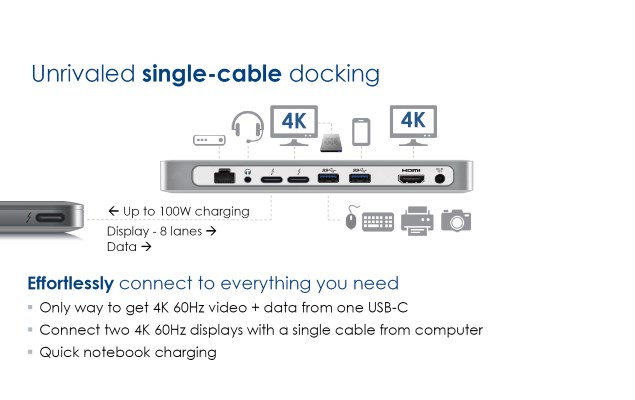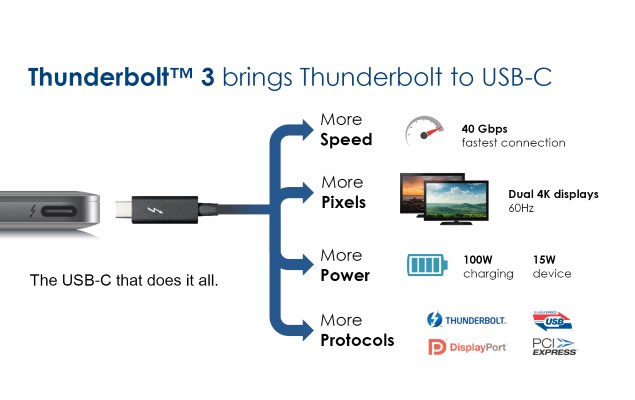Intel
has been working on its third-generation
Thunderbolt controllers for a
while now, but in a surprise move, the company announced that
Thunderbolt 3 will use the new
USB Type-C connector and also include
transportation for USB 3.1 data. Previous versions used the
Mini-DisplayPort connector.
USB Type-C will allow Thunderbolt 3 to
reach a wider audience, and also give the standard a chance on
ultra-thin devices which only have room for the new slim, reversible
connector. The standard will also support the USB Power Delivery
specification which will allow devices to negotiate for up to 100W of
power. Manufacturers who choose to adopt Thunderbolt 3 will be able to
dispense with all other ports and standards including a charging port,
and offer more versatile connectivity options than the USB Type-C
standard allows for.
Specifications for the USB Type-C connector have been published and no royalty is required to use it. However, the move does not appear to have been endorsed by the USB Implementers Forum which is responsible for governing the standard. USB Type-C already allows for multiple standards such as DisplayPort to be transported as official Alternate Modes.
Thunderbolt 3 will provide up to 40Gbps of
bidirectional bandwidth in the form of four PCIe 3.0 lanes, as well as
the capacity to carry DisplayPort 1.2 signals. Up to two 4K displays or a
single 5K display can be fed at 60Hz over a single Thunderbolt 3 link.
10Gb Ethernet transport is also supported over Thunderbolt 3, allowing
easy high-speed connections between devices.

PCIe connectivity
would even allow for external graphics cards, allowing smaller devices
to take on new functions and capabilities when docked. Hotplugging and
"surprise removal" are supported, so that users don't need to shut down
or perform specific actions when transitioning from docked to mobile and
vice versa.
Small devices such as ultraportable notebooks could
use Thunderbolt 3 docks to break out into multiple connections for
charging, networking, storage, display and more. The integrated 10Gbps
USB 3.1 controller ensures backward compatibility with millions of USB
devices. Thunderbolt allows for daisy-chaining, allowing for easier
setup and cable management. The standard is effectively a superset of
USB 3.1 and USB Type-C's capabilities.
Thunderbolt 3 will require
active copper or fibre optic cables to achieve the 40Gbps peak speed at
lengths of up to 2m and up to 60m respectively. Less expensive passive
copper cables will enable only 20Gbps of bandwidth at up to 2m.
Products
would need to be certified as Thunderbolt capable, and the first ones
are expected to ship by the end of this year with volume adoption in
2016. Intel has so far struggled to create an audience for Thunderbolt
outside of the professional content creation industry where it has
largely supplanted FireWire.
For the latest tech news and reviews, follow Gadgets 360 on X, Facebook, WhatsApp, Threads and Google News. For the latest videos on gadgets and tech, subscribe to our YouTube channel. If you want to know everything about top influencers, follow our in-house Who'sThat360 on Instagram and YouTube.
Further reading:
4k,
computex,
computex 2015,
displayport,
intel,
thunderbolt,
thunderbolt 3,
type-c,
usb,
usb 3.1,
usb type-c
 Haier M80F Series Mini LED 4K Smart TVs Launched in India: Price, Features1 April 2025
Haier M80F Series Mini LED 4K Smart TVs Launched in India: Price, Features1 April 2025 Home-Grown Startup Lumio Announces Foray Into India’s 4K Smart TV Market Backed by Flipkart, Xiaomi Officials28 February 2025
Home-Grown Startup Lumio Announces Foray Into India’s 4K Smart TV Market Backed by Flipkart, Xiaomi Officials28 February 2025 Haier M95E Mini LED Smart TV Review: Big on Features19 February 2025
Haier M95E Mini LED Smart TV Review: Big on Features19 February 2025 Google TV Streamer (4K) to Reportedly Get a New Remote With Backlit Controls Soon19 February 2025
Google TV Streamer (4K) to Reportedly Get a New Remote With Backlit Controls Soon19 February 2025 Best ZEE5 Subscription Plans 2025 with Price and Validity to Watch Movies and Series Online17 January 2025
Best ZEE5 Subscription Plans 2025 with Price and Validity to Watch Movies and Series Online17 January 2025




![Gadgets 360 With Technical Guruji: News of the Week [April 12, 2024]](https://c.ndtvimg.com/2025-04/jlpk5kco_news-of-the-week_160x120_12_April_25.jpg?downsize=180:*)








